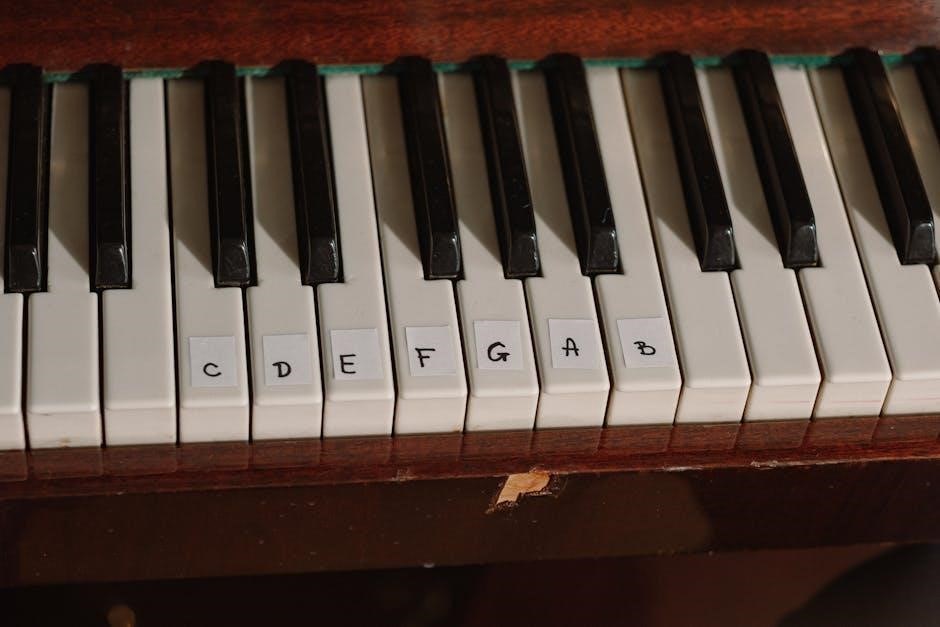Piano Scales Arpeggios PDF: A Comprehensive Guide
This guide offers comprehensive resources for piano scales and arpeggios, including downloadable PDFs and sheet music. Master major, minor, harmonic, and melodic forms with detailed fingerings and exercises. Perfect for beginners to advanced players.
Embark on a musical journey by exploring the fundamental elements of piano playing: scales and arpeggios. These essential exercises form the bedrock of technical proficiency and musical expression. This guide provides a structured approach to mastering scales and arpeggios, offering downloadable PDF resources and sheet music for various skill levels.
Scales are sequences of notes arranged in ascending or descending order, establishing a tonal foundation. Arpeggios, on the other hand, involve playing the notes of a chord in succession, creating a broken chord effect. Together, scales and arpeggios enhance finger dexterity, improve coordination, and deepen understanding of harmony.
This comprehensive guide covers major and minor scales (harmonic and melodic forms), along with major and minor arpeggios in all inversions. Discover fingering patterns, practice exercises, and resources to elevate your piano playing skills. Whether you’re a beginner or an experienced player, mastering scales and arpeggios unlocks new musical possibilities.

Understanding Scales
Scales are the foundation of melody and harmony. Learn the structure of major and minor scales, including their characteristic intervals and fingerings, to build a strong musical base.
Major Scales: Structure and Fingering
Major scales are characterized by their bright and uplifting sound, formed by a specific pattern of whole and half steps: whole, whole, half, whole, whole, whole, half. Understanding this structure is crucial for building a solid foundation in music theory and piano technique.
Each major scale has a unique fingering pattern designed to facilitate smooth and efficient playing. Mastering these fingerings allows pianists to navigate the keyboard with ease, enabling expressive performances.
This section will explore the fingering patterns for all major scales, providing detailed diagrams and exercises to help you develop proper technique. Special attention is given to scales like C major, which offers a foundational understanding, and scales with sharps and flats, where finger placement becomes more challenging.
Regular practice of major scales not only improves finger dexterity and coordination but also enhances your understanding of key signatures and harmonic relationships, essential skills for any pianist.
Minor Scales: Harmonic and Melodic Forms
Minor scales present a more somber and reflective tone compared to major scales, with two primary forms: harmonic and melodic. The harmonic minor scale raises the seventh degree, creating a distinctive interval that enhances its dramatic quality, commonly used in classical compositions.
The melodic minor scale differs in its ascending and descending forms. Ascending, it raises both the sixth and seventh degrees, while descending, it reverts to the natural minor form. This variation provides a smoother melodic contour.
Understanding the nuances of both harmonic and melodic minor scales is crucial for interpreting and performing a wide range of musical styles. This section offers detailed explanations, fingering patterns, and practice exercises for each form.
Learning these scales improves your technical skills and expands your musical vocabulary, allowing for more expressive and nuanced performances. Mastering the fingerings for each variation will enable you to navigate the keyboard fluidly, adding depth to your playing.
Understanding Arpeggios
Arpeggios are broken chords, played one note at a time. This section explores major and minor arpeggios, their inversions, and fingerings, providing a foundation for advanced piano techniques and improvisation.
Major Arpeggios: Inversions and Fingerings
Major arpeggios are built upon the 1st, 3rd, and 5th degrees of a major scale. Understanding inversions is crucial for fluent playing. A major arpeggio has three inversions: root position, first inversion, and second inversion. Each inversion utilizes different fingerings to facilitate smooth transitions across the keyboard.
In root position, the root of the chord is the lowest note. First inversion places the third of the chord as the lowest note, while the second inversion places the fifth of the chord as the lowest note. Proper fingering ensures seamless execution and allows for greater musical expression.
Practicing major arpeggios in all inversions enhances dexterity and strengthens finger independence. Mastering these fingerings unlocks new possibilities for improvisation and composition, adding depth and richness to your piano playing. Consistently practicing major arpeggios is very important.
Minor Arpeggios: Inversions and Fingerings
Minor arpeggios, built on the 1st, 3rd, and 5th degrees of a minor scale, present unique fingering challenges. Like major arpeggios, they also have three inversions: root position, first inversion, and second inversion. The fingering patterns for minor arpeggios often require adjustments compared to their major counterparts.
Root position places the root of the minor chord as the lowest note. First inversion elevates the third of the chord to the bass, and second inversion positions the fifth in the bass. Mastering these inversions is crucial for developing a comprehensive understanding of harmony.
Consistent practice of minor arpeggios in all inversions improves finger strength, coordination, and musicality. Familiarity with these patterns enhances your ability to navigate complex musical passages and improvise effectively in minor keys. Understanding these intricacies elevates your overall piano playing.

Scales and Arpeggios Exercises
Effective exercises are crucial for mastering scales and arpeggios. Practice routines should include varying octaves and tempos, improving dexterity and musicality. Consistent practice yields significant progress.
One-Octave Exercises for Beginners
For beginners venturing into the world of piano scales and arpeggios, one-octave exercises are an ideal starting point. These exercises provide a foundation for understanding basic finger placement and developing muscle memory, essential for more complex musical passages. Focusing on one octave allows students to concentrate on accuracy and evenness of tone without the added challenge of navigating multiple octaves.
Start with C major, as its straightforward fingering is quite accessible. Practice ascending and descending slowly, paying close attention to maintaining a consistent tempo and dynamics. Incorporate the harmonic minor scale early on to introduce alterations and develop a sense of its unique sound.
Arpeggios, too, can be simplified to one octave. Practice major and minor arpeggios in root position to understand the basic structure of chords. These exercises are designed to build a solid foundation for future piano skills. Regular practice, even for short periods, will gradually improve coordination and confidence.
Two-Octave Exercises for Intermediate Players
Intermediate piano players can advance their skills with two-octave scale and arpeggio exercises. Expanding to two octaves demands greater finger dexterity, hand coordination, and stamina. These exercises enhance technical proficiency and musical expression, preparing players for more challenging repertoire. Focus on maintaining consistent tempo and tone quality throughout the entire range.
Explore different scales, including major, harmonic minor, and melodic minor, in all keys. Pay close attention to fingering patterns to ensure smooth transitions between octaves. Arpeggios should be practiced in various inversions to develop a comprehensive understanding of chord structures and voice leading. Incorporate metronome work to solidify timing and rhythm.
Practice scales and arpeggios both legato and staccato to develop different articulation skills. Regular practice of two-octave exercises will build a strong technical foundation, allowing for greater musical freedom and expression. As proficiency increases, experiment with varying dynamics and phrasing to add nuance and artistry to your playing.

Resources: PDF Downloads and Sheet Music
Access free PDF downloads and sheet music for piano scales and arpeggios. Enhance your practice with valuable resources suitable for various skill levels, from beginner to advanced.
Free PDF Resources for Scales and Arpeggios
Explore a curated collection of free PDF resources designed to enhance your piano scales and arpeggios practice. These resources cater to various skill levels, offering valuable tools for beginners, intermediate, and advanced players. Discover comprehensive guides featuring major and harmonic minor scales, along with their corresponding arpeggios in all three inversions, complete with detailed fingerings.
For beginners, find introductory PDFs with one-octave scales and arpeggio exercises in all major and minor keys, providing a solid foundation. Intermediate players can benefit from resources that include two-octave scales and arpeggios, along with more complex exercises to further develop their technique. These free PDF resources offer accessible and structured learning materials to support your musical journey.
Many of the resources also include manual of scales arpeggios broken chords piano for all levels.

The Benefits of Practicing Scales and Arpeggios
Consistent practice of scales and arpeggios provides numerous benefits for pianists of all levels. Firstly, it significantly improves finger dexterity and coordination, leading to greater accuracy and fluidity in playing. Regular scale practice helps develop evenness of touch and control over dynamics, crucial for expressive performances. Arpeggios enhance your understanding of chord structures and voice leading, enabling smoother transitions between chords.
Furthermore, mastering scales and arpeggios strengthens your knowledge of key signatures and tonal relationships, essential for sight-reading and improvisation. By internalizing these fundamental patterns, you’ll be able to navigate complex musical passages with greater ease and confidence. Practicing scales and arpeggios also builds muscle memory, allowing for quicker recall and execution of musical ideas.
Ultimately, incorporating scales and arpeggios into your daily routine will accelerate your overall musical development and unlock new levels of artistry at the piano.
